
Picture found here.



Picture found here.

Picture found here.
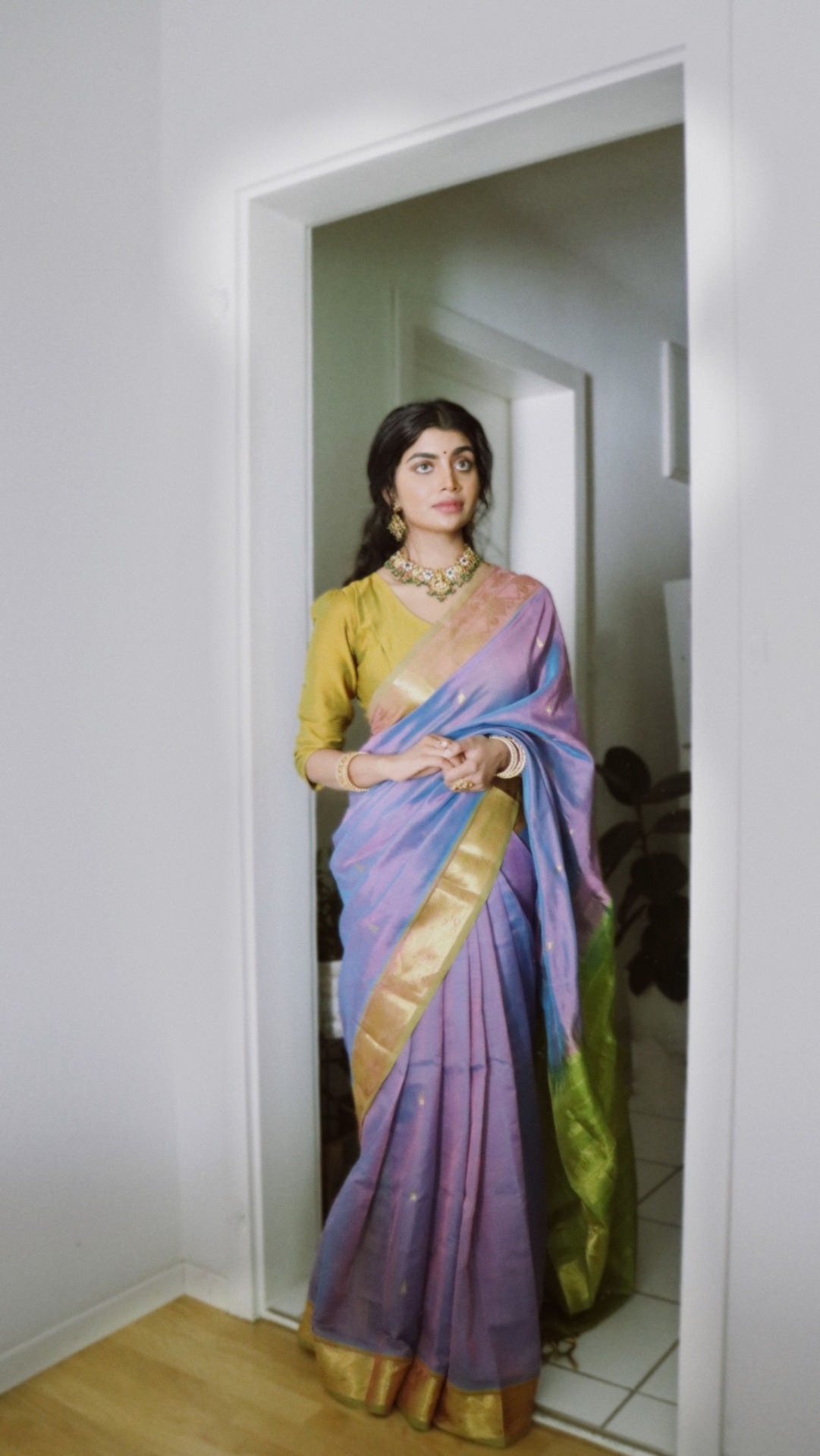
Picture found here.

Picture found here.


Picture found here.
“One day, though it might as well be somedayYou and I will rise up all the wayAll because of what you areThe prettiest star…”
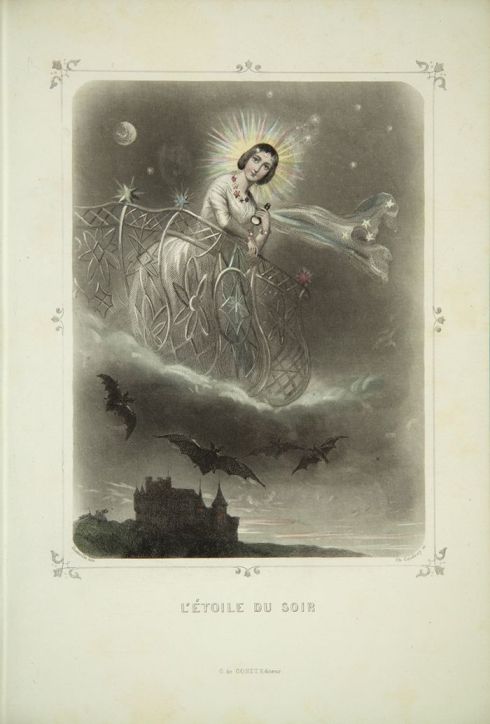 J.J. Grandville, Les étoiles du Soir (Evening Star), 1849
J.J. Grandville, Les étoiles du Soir (Evening Star), 1849
French Romantic era artist and illustrator J.J. Grandville is one of the artists whose work has captivated me in the last year. The first artwork of his that I had encountered was his litograph “The Metamorphosis of Dreams” years ago, then last spring I had written about his series of illustrations “Flowers Personified” in which flowers are depicted as beautiful damsels with different personalities. These days it is his series called “Les Etoiles” or “The Stars” from 1849 that fascinates me the most. The night-time is, after all, is so much more romantic than day and the stars are so much more mysterious than the sun. In Grandville’s wonderful romantic-bordering-on-surrealism imagination the stars are again personified as beautiful women clad in the fashions of the day. My favourite at the moment is the one above, “The Evening Star” because of its Gothic mood. The illustration shows the evening star personified as a woman standing on the balcony that arises, not out of a castle tower, but out of a cloud and looking out into the night. Ah, but she should look into the mirror, for nothing is as lovely as the evening star itself! There are rays of gold stardust shining all about her head and we can see the moon in the distance behind her. In the lower part of the illustration, down on earth, there is gloomy and isolated Gothic looking castle and bats flying about it in an ominous manner. And yet the aura around the evening stair is so serene and bringht and pure that even the gloominess of the castle 0r the eeriness of the bats cannot ruin the magic of the scene.
My other favourites are different in mood to the one above, but equal in beauty and intricacy. “The Morning Star” shows the morning star personified as a woman in a white gown in the 1840s style and a short black cape. Soft hair is dancing around her pale face and bright colourful stars are dancing above her dress and her cape in a groovy way. One star also serves as her hair decor. She is gliding through the night sky on a boat of clouds that are subservient to this goddess-like woman. She seems as soft as those clouds, as unattainable, as fleeting, for she is announcing a new day and a defeat of the night…at least for a while. Down from the ground she is being watched by some farmers, or workers, and a very curious and eager rooster who is depicted with more colour than the rest of the scene, to prove his importance of course, or at least he thinks so. “The Shooting Star” shows two lovers sitting on some meadow at night and up in the sky they are witnessing a shooting star, appearing for a moment intensely bright and strong on the night sky and then disappearing in an explosion of beauty. It is such a rare thing to see and no one can forget the moment they saw it, nor the person they were with when they saw it. I remember both times distinctly and I am very grateful that I got to see it. “The Shepherd’s Star” is a star personified as a very fashionable woman; her hair is adorned with many, many stars and the star that she is wearing as a headpiece is even grander. In contrast to the fashionable attire, her eyes seem drunk almost, or at least she seems in a sort of a haze; from love, or from drugs, or from joy, who knows. She is being watched by shepherds, a dog and some sheep. Just how magical and ethereal she is compared to the heavy, serious, and boring life down there on the ground. I love how soft the transitions are between the Lady Stars’ dresses and the clouds on which they are standing.
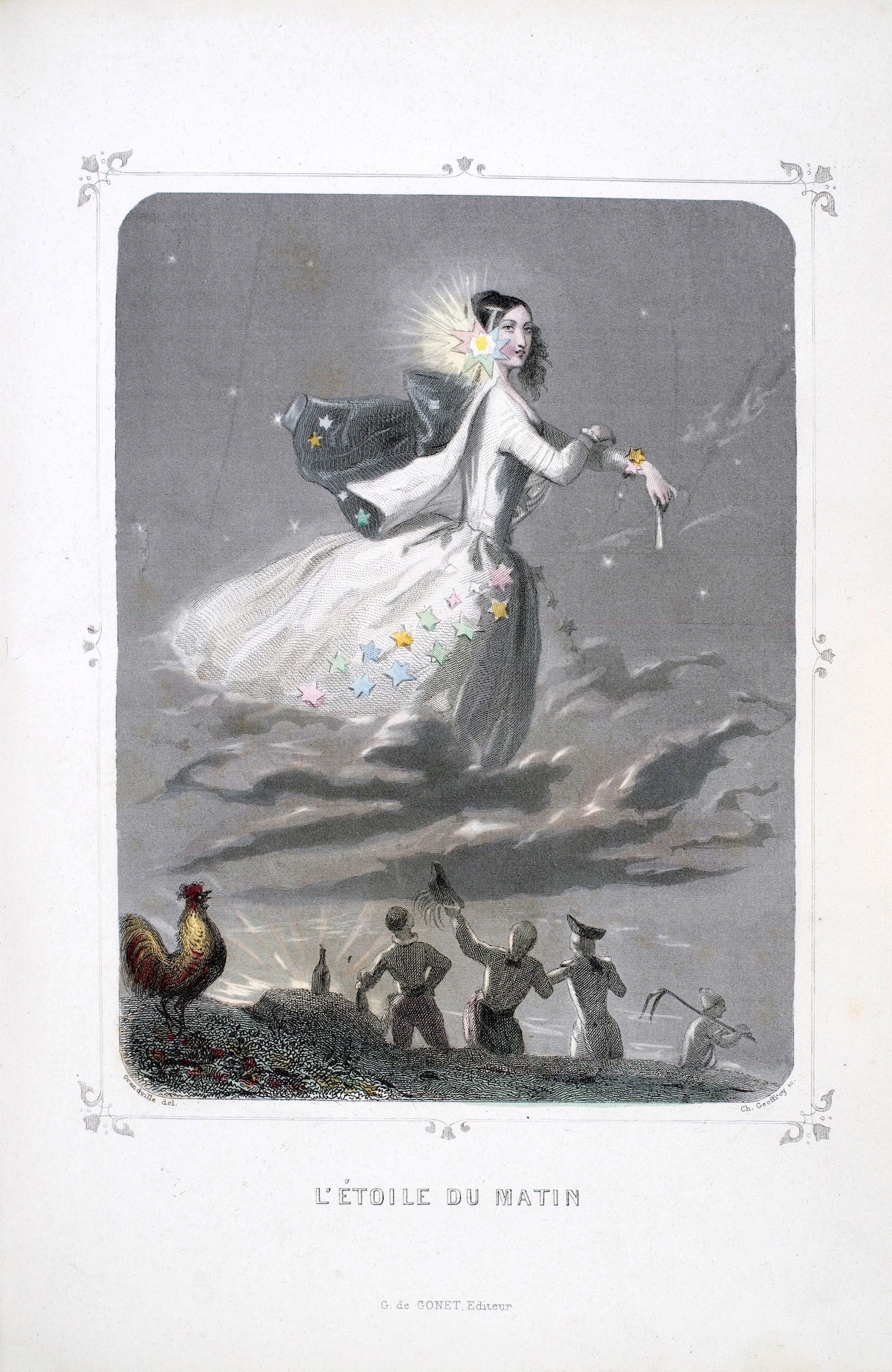
J.J. Grandville, The Morning Star, 1849

J.J. Grandville, The Shooting Star, 1849

J.J. Grandville, The Shepherd’s Star, 1849
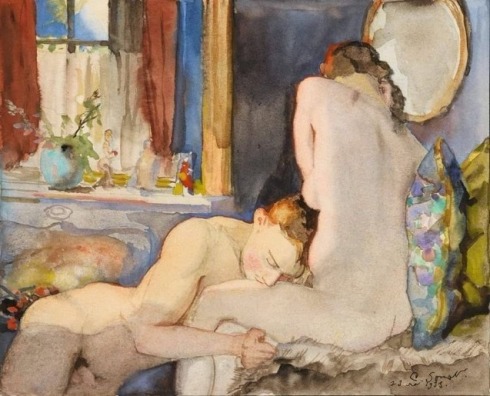 Konstantin Somov, The Lovers, 1933
Konstantin Somov, The Lovers, 1933
“I could have drowned in those so-called dreams”
(Tindersticks, Rented Rooms)
I have been tremendously interested in the paintings of the Russian painter Konstantin Somov the whole of last year and still his work holds a spell over me mainly because he so often paints lovers and because of the escapist, nostalgic tendencies that he exhibits in paintings parties and park scenes with obvious hints to the paintings of Antoine Watteau and Rococo in general. Love, pleasure and the eighteenth century; who can resist!? And yet, what I like about his watercolours of lovers such as the one above, “The Lovers”, from 1933 is its simplicity, rawness and intimacy. While his eighteenth-century inspired paintings have an air of glamour, fun and slight decadence to them, these kind of watercolours are pure in that they depict a genuine emotion, a softness and tenderness between lovers which doesn’t seem like a scene from a comedy. It is more as if we are peeking through the keyhole and witnessing what we ought not to be witnessing. The fact that it was set in that time and not in some idealised past era also brings this sense of intimacy and immediacy. The poses of the lovers are not theatrical as his eighteenth-century depictions of lovers often are, but tender; the man is laying his head in the lap of the women, perhaps the safest place in the world for him, a flowery meadow of calmness and inspiration. One of her bosom is touching his head, but her head is turned away, she seems shy, or closed-off perhaps, or maybe I am reading too much into it. The other elements in the watercolour; the mirror, cushions, flowers on the windowsill, opened window, all brings a sense of domesticity and joy. The medium of watercolours truly fits the gentle mood of the scene.
The watercolour made me think of Tinderstick’s song “Rented Rooms” from their album “Curtains” (1997) which is about lovers stealing time to be together, rushing to all the secretive places where they can give in to their intimate urges. The relationship in the song is one characterised by a sense of impermanence, restlessness and instability, and not of the exciting kind because the lovers have a deep desire to connect but the physical union alone leaves them feeling again restless and yearning for more. Especially the lines “We can’t afford the time to sit and cry or to wonder why…” makes me think of this watercolour because lovers are always in a frenzy, with so many kisses yet to happen, who has time to sit and think about things!? In Somov’s another watercolour, “Daphnis and Chloe”, painted in 1931 and shown bellow, we again see the lovers tenderly depicted, though there is more of an erotic touch here for sure; the man is holding the woman around the waist and closing her eager-to-chit-chat lips with a kiss until they sink down in a bed of dreams. The woman’s rosy cheeks and her golden hair cascading down her neck and breasts give her a doll-like, elegant appearance.
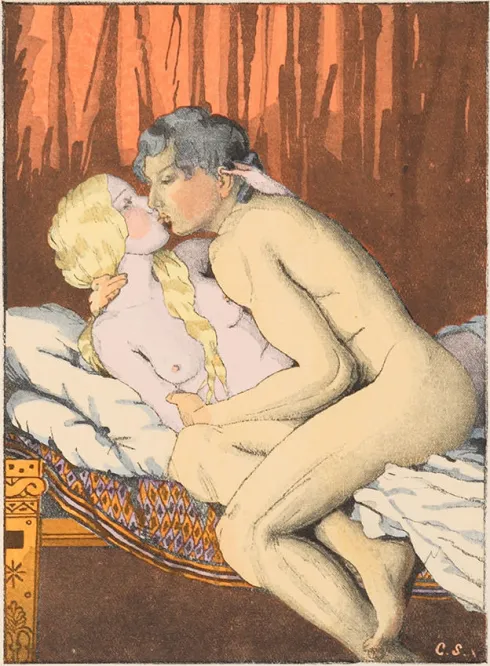
Konstantin Somov, Daphis and Chloe, 1931, watercolour
“I never knew that you’d get married
I would be living down here on my own
On that damp and lonely Thursday years ago…”
Pulp’s song “Disco 2000” from their 1995 album “Different Class” is a song about the singer Jarvis Cocker’s childhood crush Deborah, but told through the lense of adulthood. The song is based on real events from Cocker’s childhood; there was indeed a girl called Deborah who was popular and pretty, but had no interest in Cocker and didn’t notice him at all. In the song he fantasises about meeting her at some distant point in the future, in the year 2000, when they’re both grown ups. There is a wittiness and a sense of humour, a slight self-deprecation which are all always present in Pulp’s songs but there is also a tinge of sadness, especially as the song’s narrator is realising that his childhood crush is now married while he is single and lonely on that damp Thursday: “I never knew that you’d get married/ I would be living down here on my own/ On that damp and lonely Thursday years ago….” There is even a cute sort of desperation when he sings “Oh, what are you doing Sunday, baby?/ Would you like to come and meet me, maybe?/ You can even bring your baby…” He doesn’t even care that she is with somebody, as long as he can see her.




Stills from the music video.
It is as if in one moment you are a carefree teen sitting bored in school, fantasising what your adult life might be, and you blink and suddenly you are twenty-something and your peers are getting married and having children. Doors are closing, opportunities being limited. We all have a certain someone that we fancied back in high school, or even primary school and we may have had certain fantasies and now we may have the what-ifs. That interest may have been only one-sided, or both parties may have been too shy to act upon anything… Time passes and school finishes. We move on with our life and we forget about that person, but there is always a warm, pure feeling to the memory. And the memory is pure and warm precisely because nothing happened; if something did happen, then it would likely leave us disappointed, as most school-age ‘loves’ do. Something that could have been always has more charm than something that is. For those living in small towns such as myself the feeling is even stronger because there is less people to see and it is almost impossible to avoid certain people even if we want to. Someone that was a rebel-without-a-cause, sitting with you in the last row in biology class and cracking jokes is now delivering pizza and you pretend not to see them when you do see them. I guess we’ll never meet at the fountain by the road.

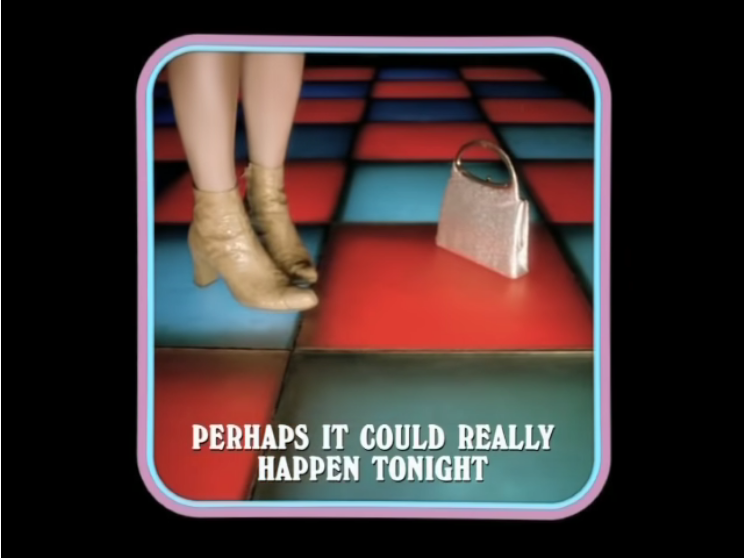


And I said, “Let’s all meet up in the year 2000Won’t it be strange when we’re all fully grown?Be there two o’clock by the fountain down the road”I never knew that you’d get marriedI would be living down here on my ownOn that damp and lonely Thursday years ago




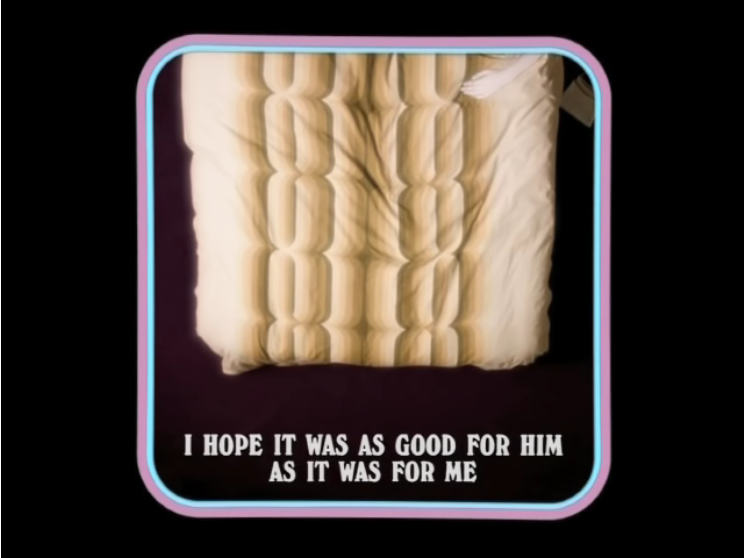

“Primavera”; a poem celebrating spring from Louise Gluck 2006 poetry collection “A Village Life”. The motifs such as plum tree blossoming and birds singing are something dear and near to me at the moment because spring is indeed here and with it comes joy and lightness of life. I especially love the second to last line which describes the blossoms as the emblems of the resiliance of life. Trees, and the rest of nature, have their time to bloom and flourish just as they have their time to shed their leaves and let their branches be bare. They don’t resist it and they always have hope. Our lives too are made of seasons and even if we feel that our lives are in a spiritual state of winter – spring of the soul will inevitably follow.
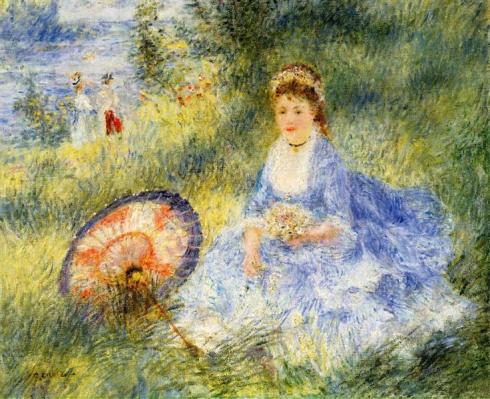 Renoir, Young Woman with a Japanese Umbrella, 1876
Renoir, Young Woman with a Japanese Umbrella, 1876
Primavera
Spring comes quickly: overnight
the plum tree blossoms,
the warm air fills with bird calls.
In the plowed dirt, someone has drawn a picture of the sun
with rays coming out all around
but because the background is dirt, the sun is black.
There is no signature.
Alas, very soon everything will disappear:
the bird calls, the delicate blossoms. In the end,
even the earth itself will follow the artist’s name into oblivion.
Nevertheless, the artist intends
a mood of celebration.
How beautiful the blossoms are—emblems of the resilience of life.
The birds approach eagerly.
 Alphonse Mucha, Girl With a Plate With a Folk Motif, 1920
Alphonse Mucha, Girl With a Plate With a Folk Motif, 1920
The first thing that catches my attention about this portrait is the girl’s eyes; concentrated, focused, not blinking and not shying away, but staring deep into my soul. With a gaze like that, one might assume this was a portrait of a femme fatale or some enchantress from Arthurian legends, but actually the portrait shows the Czech Art Nouveau artist Alphonse Mucha’s pretty daughter Jaroslava who was eleven years old at the time this portrait was painted. A great poser she seems to have been; like mother, like daughter, I might say because Mucha’s wife Maria Chytilová was his muse and often posed for his paintings. Seriously, who the hell looks this badass while holding a paintbrush in one hand and a pretty plate in another!? Jaroslava studied ballet, but decided to give that up and follow her father’s footsteps. She not only posed for him, but also helped him out in the studio, by mixing colours for his Slav Epic and also painting the starry sky in the painting “Slavs in their Original Homeland: Between the Turanian Whip and the sword of the Goths”. After the World War II, Jaroslava even worked on restoring the paintings from the Slav Epic which had been damaged during the war due to bad storing conditions. It seems that the determined look in her eyes in the portrait isn’t just an aesthetic thing, but a representation of her character. I love everything about this portrait; her eyes the most, but also her pose, the way she is showing off that pretty plate with floral folk motifs, and the way her pinky finger is resting coquettishly on her upper lip. The yellow flower in her long, flowing hair makes her seem like a free-spirited hippie girl and the white dress she is wearing, with a puff sleeve tightened with a red ribbon, appear peasant like which perhaps goes well with the folk motif on the porcelain plate. The motif on the plate with a stylised tulips and sunflowers is both simple and charming. The blue background is echoed by traces of blue and lilac in her hair. The brush in her hand seems to say; you may think I am a muse, but I have a few artistic tricks up my sleeves as well.
A book that touched me deeply this March was Balzac’s “Eugenie Grandet” as you could have read about in my previous post. I also enjoyed Mason Currey’s book “Daily Rituals – How Artists Work” which I might write about on some other occassion… I am nearly finished with two other interesting books; Ernest Hemingway’s “A Moveable Feast” and a book which I have been wanting to read for years and it is Jean Nathan’s “The Secret Life of the Lonely Doll” which is a biography on Dare Wright, a strange and whimsical photographer, model and children’s book author famous for her 1957 children’s book “The Lonely Doll” and I have included some of her doll-photography in the post. The theme of indolence and the joy of the arrival of spring were my main themes for March.
“When spring came, even the false spring, there were no problems except where to be happiest. The only thing that could spoil a day was people and if you could keep from making engagements, each day had no limits. People were always the limiters of happiness except for the very few that were as good as spring itself.”
(Ernest Hemingway, A Moveable Feast)
“And now it’s spring, so my ideas are always so nice, sharp, inventive, and the dreams I have are tender; everything is rose-coloured.”
(Fyodor Dostoevsky, Poor People)
“In the life of the soul, as in the physical life, there is an inspiration and a respiration; the soul needs to absorb the sentiments of another soul and assimilate them, that it may render them back enriched. Were it not for this glorious human phenomenon, there would be no life for the heart…”
(Balzac, Eugenie Grandet)
“She was a pixie, a fairy, full of imagination and in another world.”
(Jean Nathan – The Secret Life of the Lonely Doll)
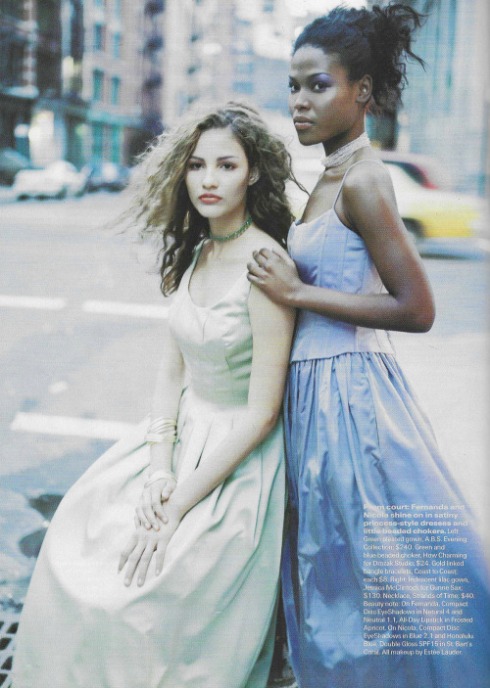 March 1997. ‘Romantic dresses, cute guys in tuxes and a walk through the city at dusk. Does it get any more glam than this?’
March 1997. ‘Romantic dresses, cute guys in tuxes and a walk through the city at dusk. Does it get any more glam than this?’
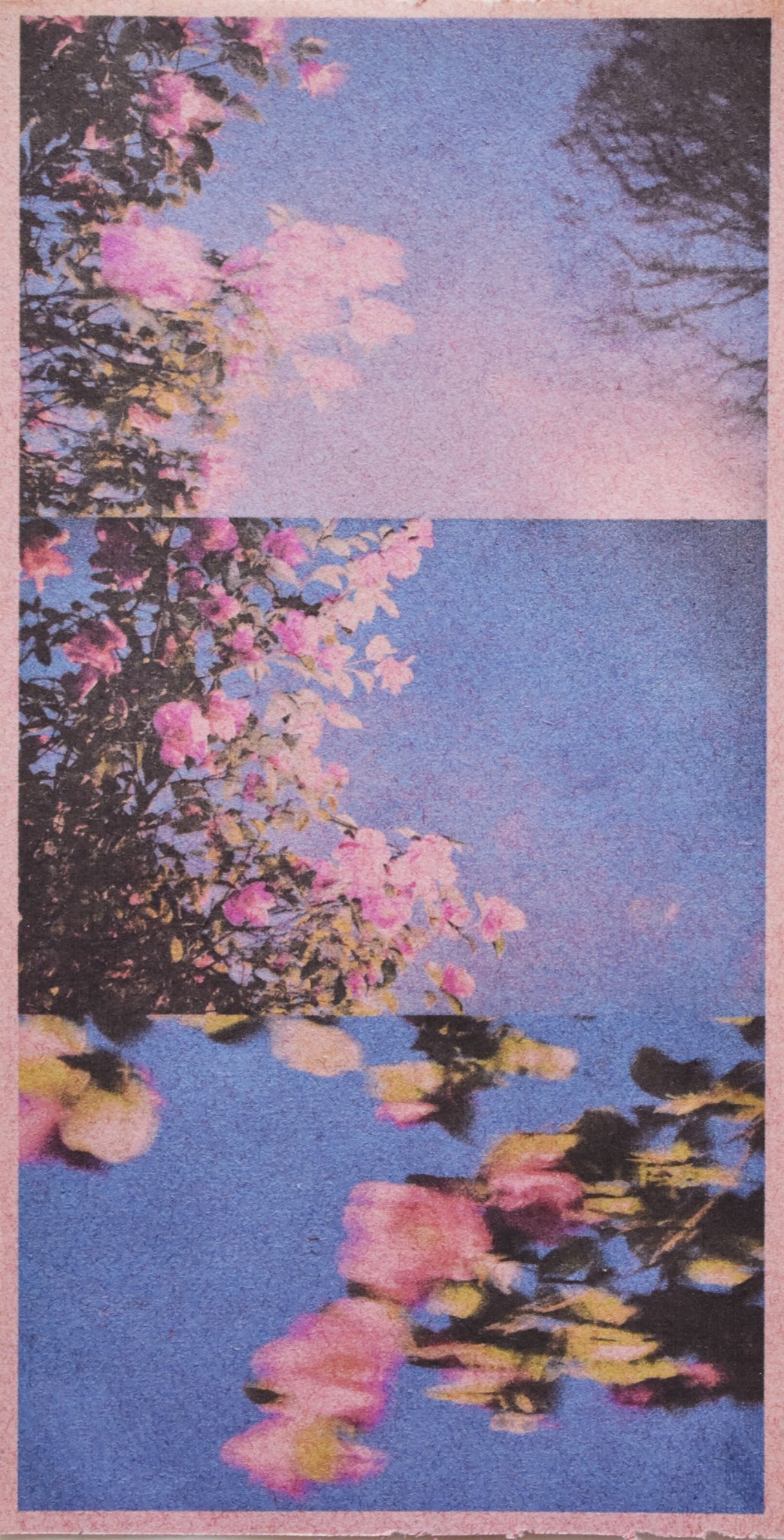
Night Fragments by Jana Sojka.
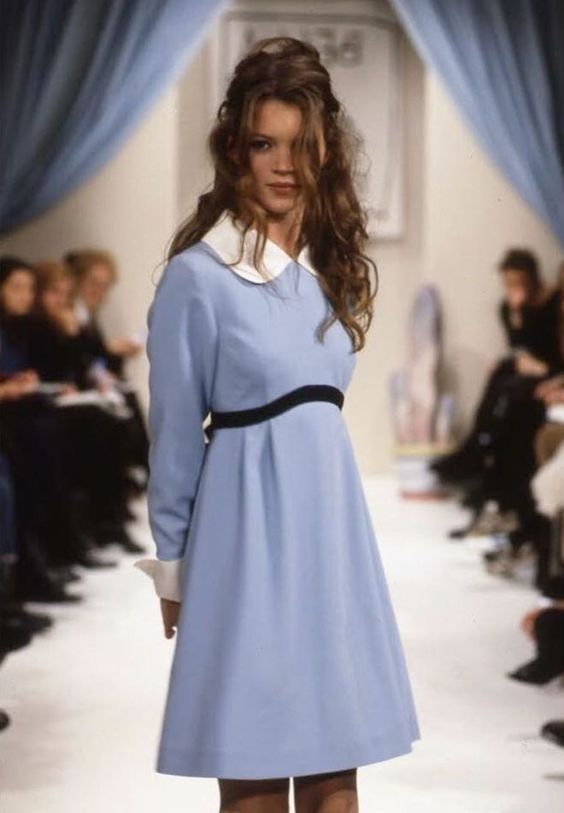

by teresacfreitas.

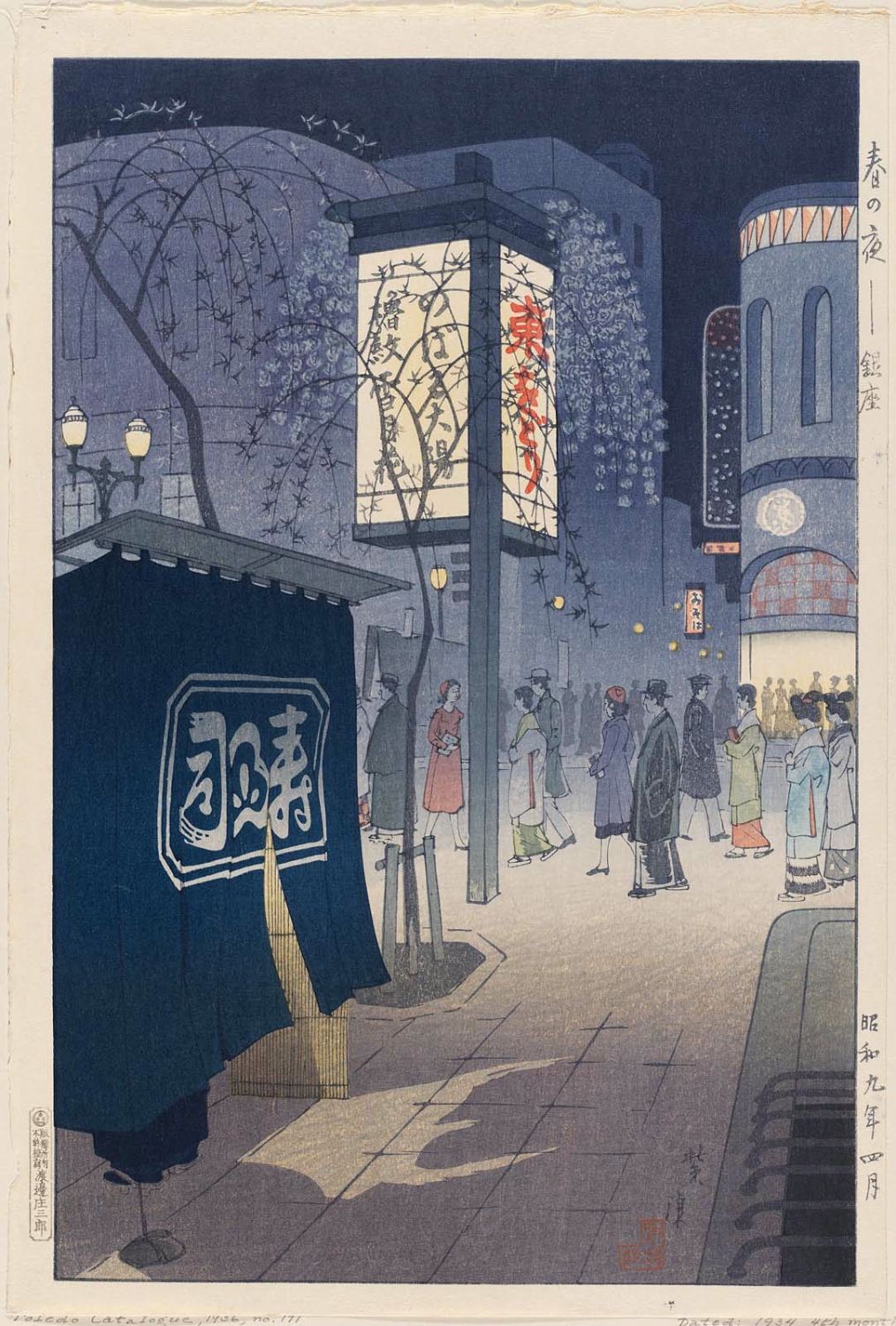

by teresacfreitas.



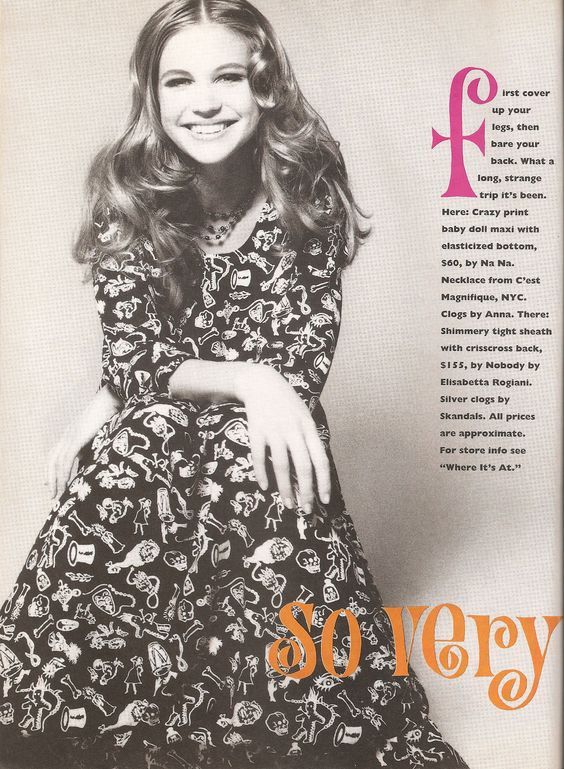

Moon Landscapes, Spring, by Jana Sojka.





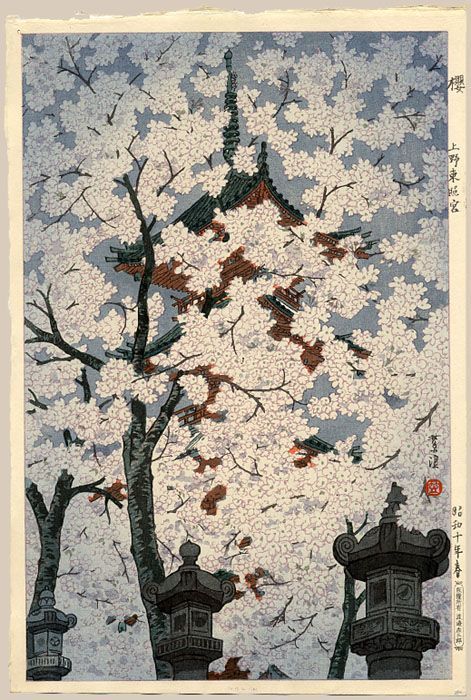
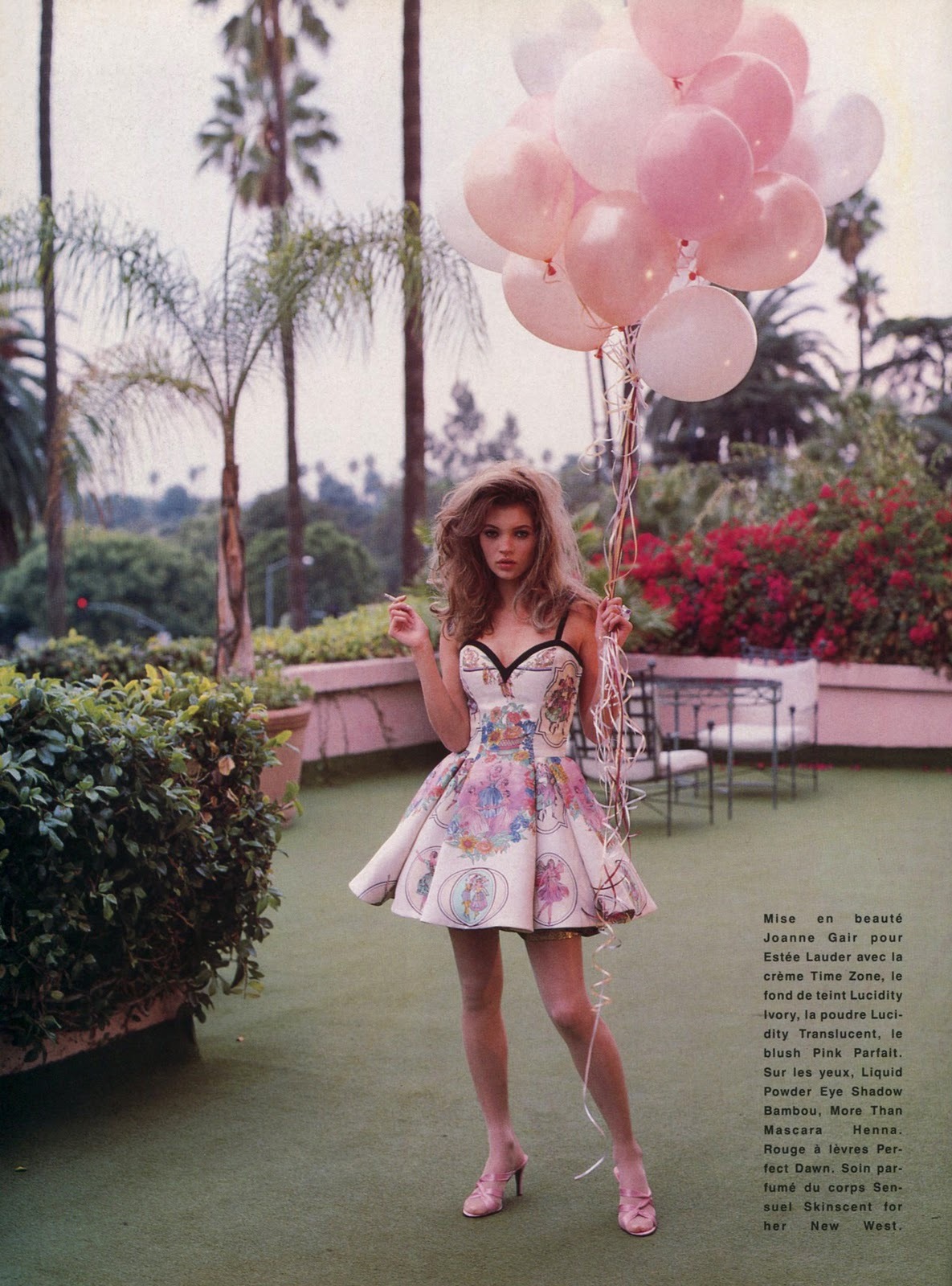



Misty mountain, Mount Yoshino, Nara, Japan. Picture found here.


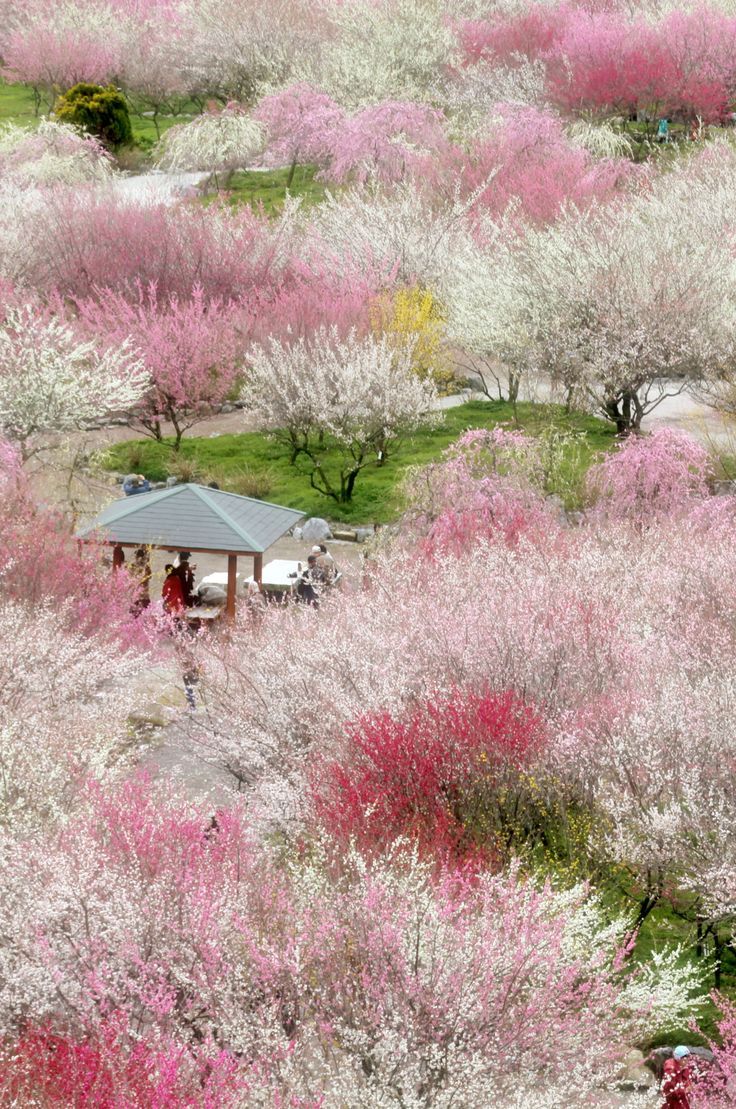
Japan: Cherry blossoms in full bloom at Mount Yoshino, Nara. Picture found here.
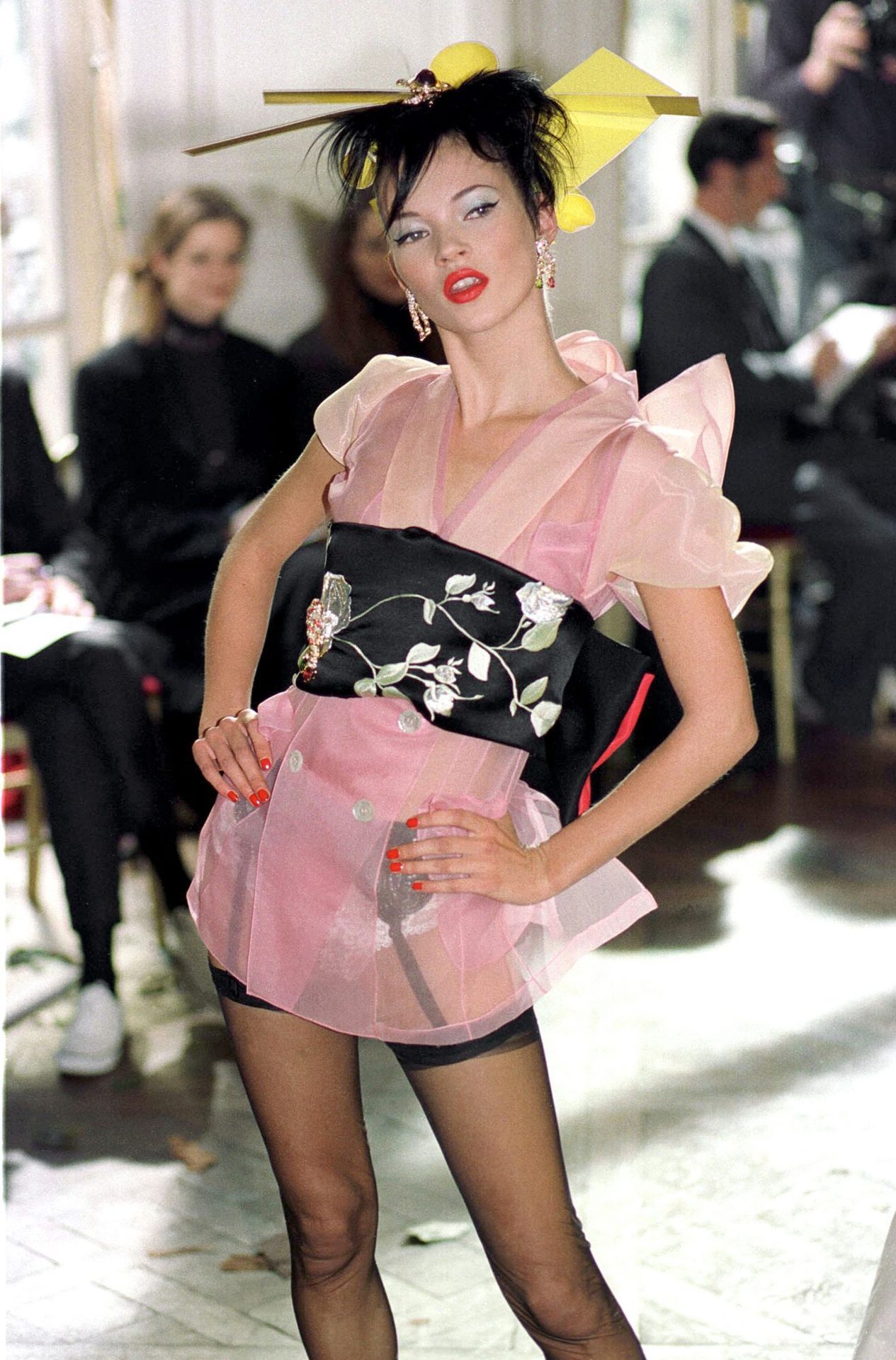

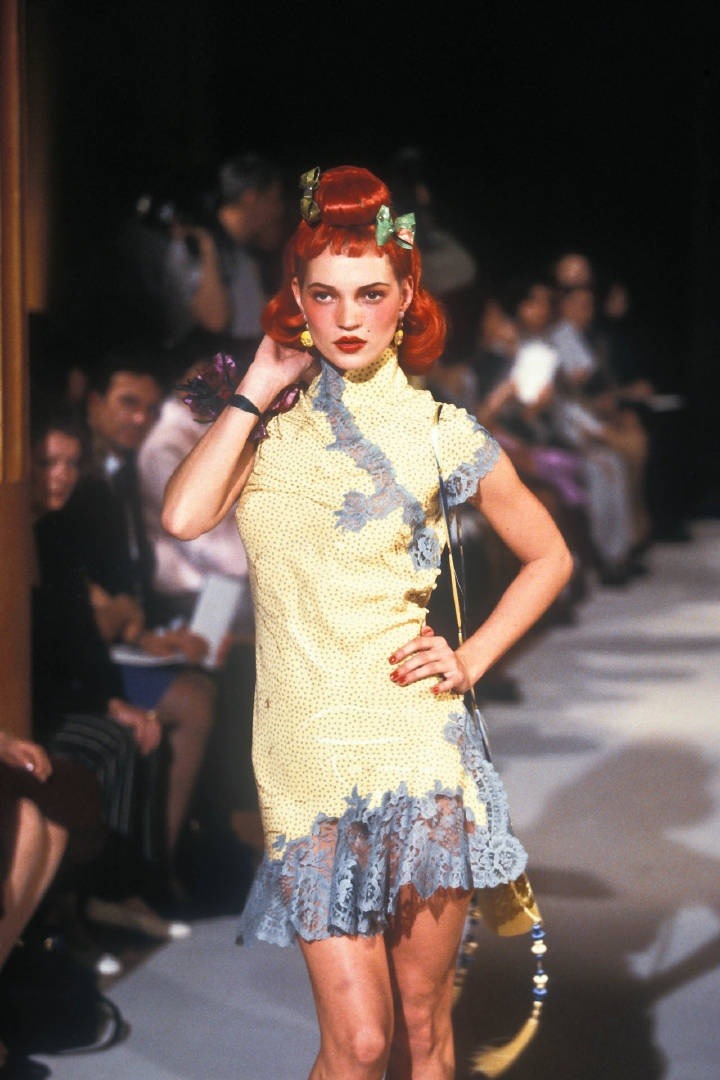


Picture found here.










*
“Eugenie was standing on the shore of life where young illusions flower, where daisies are gathered with delights ere long to be unknown.”
 Camille Corot, Femme Lisant, 1869
Camille Corot, Femme Lisant, 1869
When I picked up Honore de Balzac’s novel “Eugénie Grandet” from my bookshelf I was hoping for hours of amusement, but I couldn’t anticipate just how touched to the core I would feel after finishing it. I had read his “Father Goriot” before and I found it a tad tedious to say the least, the flow of the novel too burdened by unnecessary descriptions of places and people, but “Eugenie Grandet” was the opposite; shorter and more to the point, more melancholy and intimate, and sad in its realism. If you are looking for a happy ending, do not read this book. The novel was first published in 1833 and it was part of Balzac’s “The Human Comedy”; a series of novels written from 1829 to 1848 that serve as a portrait of French society in the periods of Restoration (1815-30) and the July Monarchy (1830-48). Balzac even made subcategories for his novels and “Eugenie Grandet” was put in the “Scenes from provincial life” category. Interestingly, the novel was also translated by Dostoyevsky into Russian in 1843 and this translation marks the beginning of his literary career.

Zinaida Serebriakova, Collioure – Bridge with goats, 1930
“Eugenie Grandet” is a tale of a monotonous provincial life, greed and disillusionment set in the town of Saumur in 1819. The novel’s main character is a young woman called Eugenie Grandet who lives with her stingy old father Felix, a long-suffering mother who is her only friend, and a kind-hearted maid Nanon. Felix Grandet hides his wealth from everyone and forces his family to live on meager means and is keen on controlling every gram of butter and flour that is spent. There is no joy or love in the Grandet household. The novel in fact commences with a description of the Grandet house and this is important because the dark and gloomy house explains the pyschology of the characters, and later on it even becomes more important because it symbolises Eugenie’s life itself:
“There are houses in certain provincial towns whose aspect inspires melancholy, akin to that called forth by sombre cloisters, dreary moorlands, or the desolation of ruins. Within these houses there is, perhaps, the silence of the cloister, the barrenness of moors, the skeleton of ruins; life and movement are so stagnant there that a stranger might think them uninhabited, were it not that he encounters suddenly the pale, cold glance of a motionless person, whose half-monastic face peers beyond the window-casing at the sound of an unaccustomed step.“
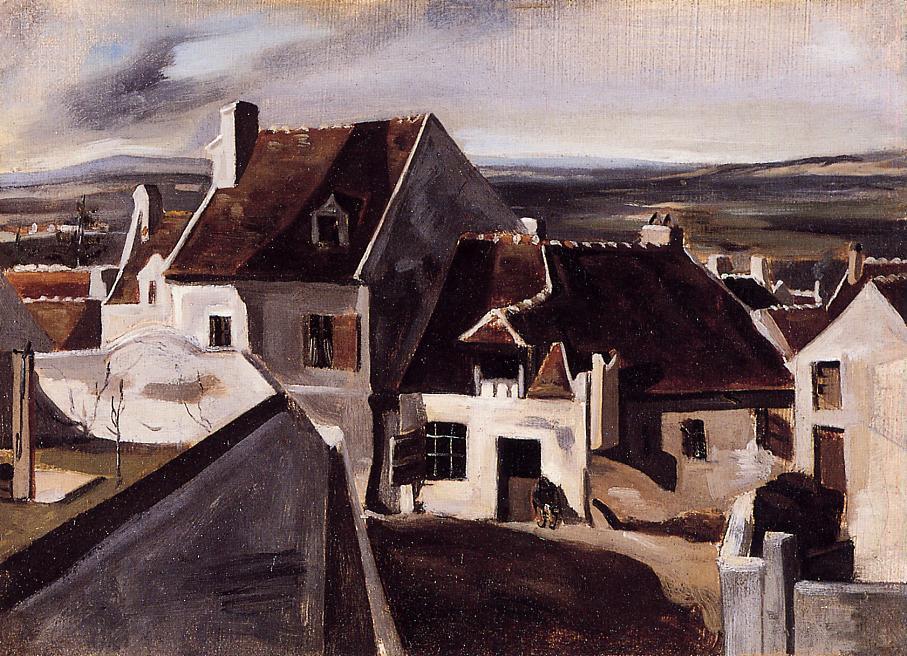
Camille Corot, The Inn at Montigny les Cormeilles, 1830
The monotonous existence of the Grandet family is disturbed one day by an unexpectant visit; Felix’s nephew Charles came to Saumur, sent by his father, Felix’s estranged brother Guillaume who had spent the last thirty years living in Paris. Now, Guillaume is bankrupt and is planning to commit suicide and he sent his unaware son Charles to Saumur hoping that Felix will aid him in going to India. Charles is a handsome young man with an aristocratic elegance but like a true child of Paris he is too shallow and doesn’t believe in anything really. At first, he is devastated to learn of his father’s death and the unfortunate financial situation, but over time he and Eugenie fall in love. Before he leaves for India, they swear to remain true to one another and Eugenie gives him her collection of rare gold coins. The secret of Eugenie’s love brings the three women closer and all three are lonely creatures, birds trapped in Felix’s birdcage. But a sad love is better than no love it seems, for Nanon says: “If I had a man for myself I’d—I’d follow him to hell, yes, I’d exterminate myself for him; but I’ve none. I shall die and never know what life is.“ I found this passage about the differences between men and women interesting; while Eugenie was pining, waiting, yearning and suffering, at least Charles had agency in life:
“In all situations women have more cause for suffering than men, and they suffer more. Man has strength and the power of exercising it; he acts, moves, thinks, occupies himself; he looks ahead, and sees consolation in the future. It was thus with Charles. But the woman stays at home; she is always face to face with the grief from which nothing distracts her; she goes down to the depths of the abyss which yawns before her, measures it, and often fills it with her tears and prayers. Thus did Eugenie. She initiated herself into her destiny. To feel, to love, to suffer, to devote herself,—is not this the sum of woman’s life? Eugenie was to be in all things a woman, except in the one thing that consoles for all.”

Camille Corot, Girl Weaving a Garland, 1860-65
As a little digression, I have to say that while reading the novel I had the paintings of the French painter Camille Corot in mind, many of which were painted around the same time when the novel was published. Not only because of the motifs painted, but because of the dark, murky, and earthy colours. Charles’ arrival brought excitement into the Grandet household and Eugenie’s entire world had changed forever; once touched by love, the first time touched by love, a woman is never the same. For Eugenie, it was suddenly as if the flowers smelt better, the sky was bluer, and the future seemed brighter:
“Art thou well? Dost thou suffer? Dost thou think of me when the star, whose beauty and usefulness thou hast taught me to know, shines upon thee? – In the mornings she sat pensive beneath the walnut-tree, on the worm-eaten bench covered with gray lichens, where they had said to each other so many precious things, so many trifles, where they had built the pretty castles of their future home. She thought of the future now as she looked upward to the bit of sky which was all the high walls suffered her to see; then she turned her eyes to the angle where the sun crept on, and to the roof above the room in which he had slept. Hers was the solitary love, the persistent love, which glides into every thought and becomes the substance, or, as our fathers might have said, the tissue of life.“

Edvard Munch, Spring, 1889
On a New Year’s Day, as a family tradition, Felix asks his daughter to show him the coins but she refuses. As a punishment, he locks her in the room and gives her nothing but bread and water. Felix’s behavior, along with the austerity in the house, take a toll on his wife and she grows weak and eventually dies:
“Madame Grandet rapidly approached her end. Every day she grew weaker and wasted visibly, as women of her age when attacked by serious illness are wont to do. She was fragile as the foliage in autumn; the radiance of heaven shone through her as the sun strikes athwart the withering leaves and gilds them. It was a death worthy of her life,—a Christian death; and is not that sublime? In the month of October, 1822, her virtues, her angelic patience, her love for her daughter, seemed to find special expression; and then she passed away without a murmur. Lamb without spot, she went to heaven, regretting only the sweet companion of her cold and dreary life, for whom her last glance seemed to prophesy a destiny of sorrows. She shrank from leaving her ewe-lamb, white as herself, alone in the midst of a selfish world that sought to strip her of her fleece and grasp her treasures.
“My child,” she said as she expired, “there is no happiness except in heaven; you will know it some day.”

Camille Corot, The Letter, 1865
Eugenie takes on her mother’s duties in the house and life continues as monotonously as before. Felix dies and Eugenie is now a wealthy young woman. She is still hopeful and waiting for Charles… But circumstances have changed Eugenie, hardened her even against her will:
“At thirty years of age Eugenie knew none of the joys of life. Her pale, sad childhood had glided on beside a mother whose heart, always misunderstood and wounded, had known only suffering. Leaving this life joyfully, the mother pitied the daughter because she still must live; and she left in her child’s soul some fugitive remorse and many lasting regrets. Eugenie’s first and only love was a wellspring of sadness within her. Meeting her lover for a few brief days, she had given him her heart between two kisses furtively exchanged; then he had left her, and a whole world lay between them. (…) In the life of the soul, as in the physical life, there is an inspiration and a respiration; the soul needs to absorb the sentiments of another soul and assimilate them, that it may render them back enriched. Were it not for this glorious human phenomenon, there would be no life for the heart; air would be wanting; it would suffer, and then perish. Eugenie had begun to suffer. For her, wealth was neither a power nor a consolation; she could not live except through love, through religion, through faith in the future. Love explained to her the mysteries of eternity. (…) She drew back within herself, loving, and believing herself beloved. For seven years her passion had invaded everything.”

Camille Corot, A Pond in Picardy, 1867
Seven years pass before his return; Charles is now wealthy and excited to show off in Paris, but the pure feelings of love and tenderness that he felt towards Eugenie had all faded. Travel has changed him; he lost his moral compass, if he ever had it in the first place, and “his heart grew cold, then contracted, and then dried up.” He writes to Eugenie about his change of heart, telling her also that her provincial lifestyle is not compatible with his life, and that love is merely an illusion really.
“…travelling through many lands, and studying a variety of conflicting customs, his ideas had been modified and had become sceptical. He ceased to have fixed principles of right and wrong, for he saw what was called a crime in one country lauded as a virtue in another. In the perpetual struggle of selfish interests his heart grew cold, then contracted, and then dried up. The blood of the Grandets did not fail of its destiny; Charles became hard, and eager for prey. (…) If the pure and noble face of Eugenie went with him on his first voyage, like that image of the Virgin which Spanish mariners fastened to their masts, if he attributed his first success to the magic influence of the prayers and intercessions of his gentle love, later on women of other kinds, —blacks, mulattoes, whites, and Indian dancing-girls,—orgies and adventures in many lands, completely effaced all recollection of his cousin, of Saumur, of the house, the bench, the kiss snatched in the dark passage. He remembered only the little garden shut in with crumbling walls, for it was there he learned the fate that had overtaken him; but he rejected all connection with his family… Eugenie had no place in his heart nor in his thoughts, though she did have a place in his accounts as a creditor for the sum of six thousand francs.“

Camille Corot, Portrait of Madame Charmois, 1837
Eugenie marries a man Cruchot whom she doesn’t love and who only wants her wealth but only under the condition that the marriage is not consummated. Cruchot too then dies. Eugenie is left alone in that dark and drab house which is now a reflection of her life. The novel is really a tale of Eugenie’s rite of passage; she grows from an innocent and inexperienced provincial girl who knows nothing about the world into a mature and wise woman whose heart is closed and whose tender feelings have all hardened. The disillusionment in love brought on a disenchantment with the world and life itself. She is alone and lonely, with no one but Nanon to love her, but Nanon too will die one day. When I was reading these kind of novels years ago, before I knew what love or loss were, I read them with a mix of curiosity and a detached sadness. These days, though, it is impossible not to be touched by such stories as Eugenie’s. Once you get your hopes high and life disappoints, it is almost impossible to raise them as high again. Life etches itself into your soul and it is hard to be blind and naive again and see things through rose-tinted glasses. Eugenie’s tale isn’t even sad, it’s just realistic. This is life; love brings disappointment and loneliness is always a step away. The last page leaves us with an image of Eugenie of continuing her father’s stingy habits because it is something familiar to her, but in truth, the money had brought her nothing but misery:
“Madame de Bonfons became a widow at thirty-six. She is still beautiful… Her face is white and placid and calm; her voice gentle and self-possessed; her manners are simple. She has the noblest qualities of sorrow, the saintliness of one who has never soiled her soul by contact with the world; but she has also the rigid bearing of an old maid and the petty habits inseparable from the narrow round of provincial life. In spite of her vast wealth, she lives as the poor Eugenie Grandet once lived. The fire is never lighted on her hearth until the day when her father allowed it to be lighted in the hall, and it is put out in conformity with the rules which governed her youthful years. She dresses as her mother dressed. The house in Saumur, without sun, without warmth, always in shadow, melancholy, is an image of her life. She carefully accumulates her income, and might seem parsimonious did she not disarm criticism by a noble employment of her wealth. (…) that noble heart, beating only with tenderest emotions, has been, from first to last, subjected to the calculations of human selfishness; money has cast its frigid influence upon that hallowed life and taught distrust of feelings to a woman who is all feeling.
“I have none but you to love me,” she says to Nanon.”
“When spring came, even the false spring, there were no problems except where to be happiest. The only thing that could spoil a day was people and if you could keep from making engagements, each day had no limits. People were always the limiters of happiness except for the very few that were as good as spring itself.”
(Ernest Hemingway, A Moveable Feast)
 Henri le Sidaner, Soir de Printemps, c. 1920
Henri le Sidaner, Soir de Printemps, c. 1920
Henri le Sidaner is amongst my new favourite artists because his paintings are just so damn dreamy and this painting, “Soir de Printemps” is no exception. The painting shows a view of the houses and blooming trees one evening in spring. Henri le Sidaner loved painting landscapes and gardens, overall he had a penchant for portraying places uninhabited by people or even animals, places which he could then, using the colours of his emotions, transform into landscapes and gardens of his dreams. The mood of his paintings is often dreamy, tinged with an inexplicable melancholy and a sense of beauty inevitably passing away, just like the warmth of summer does. In “Soir de Printemps” there is dreaminess, but no sadness. I dare say there is even a sense of excitement, and surely the painter must have felt excited as he gazed at this scene himself. An evening in spring is made for daydreams and the heart is filled to the brim with the beauty and fragrance of the blooming trees, and we are eager to take in all this transient beauty before the petals fall off, or are carried away by the wind. The houses with windows here and there from which a warm yellow lighth can be seen, and the trees in bloom create a lovely pattern and almost nothing else apart from these two motifs can be scene. The colour palette of lilac, grey, and blue perfectly encapsulated that hazy moment when the evening is falling in spring, as if the fairies themselves have woven a magical cloak and are covering the entire nature with it. I love the softness and vagueness of the scene, it is painted as if the painter was seeing the world through a gauze curtain. The tender, transient beauty of the blooming trees of early spring is truly unparalleled, especially after long, dreary months of winter.